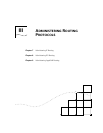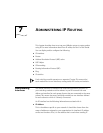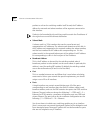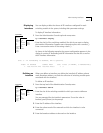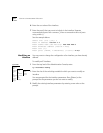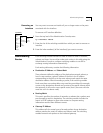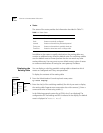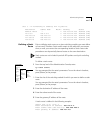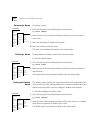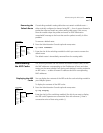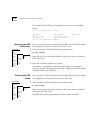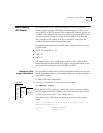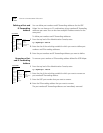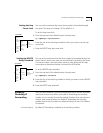
Administering Routes 7-7
Defining a Static
Route
Prior to defining static routes on a given switching module, you must define
at least one IP interface. Static routes remain in the table until you remove
them, or until you remove the corresponding interface. Static routes take
precedence over dynamically-learned routes to the same destination.
Static routes are not included in periodic RIP updates sent by the switching
module.
To define a static route:
1 From the top level of the Administration Console, enter:
ip route static
You are prompted for the route’s parameters. To use the value in brackets,
press [Return] at the prompt.
2 Enter the slot of the switching module for which you want to define a static
route.
You are prompted for the route’s parameters. To use the value in brackets,
press [Return] at the prompt.
3 Enter the destination IP address of the route.
4 Enter the subnet mask of the route.
5 Enter the gateway IP address of the route.
A static route is defined in the following example:
Select slot {3-4} [3-4]: 3
Enter destination IP address:
158.101.4.0
Enter subnet mask [255.255.0.0]: 255.255.255.0
Enter gateway IP address: 158.101.2.8
Slot 3 - IP forwarding is enabled, RIP is passive.
Destination Subnet mask Metric Gateway Status
Default Route -- 2 158.101.112.250 Learned (RIP)
10.0.0.0 255.0.0.0 8 158.101.112.254 Learned (RIP)
129.213.0.0 255.255.0.0 7 158.101.112.254 Learned (RIP)
137.39.0.0 255.255.0.0 2 158.101.112.250 Learned (RIP)
139.87.0.0 255.255.0.0 4 158.101.112.254 Learned (RIP)
Top-Level Menu
system
ethernet
fddi
tokenring
bridge
➧ip
ipx
appletalk
snmp
analyzer
script
logout
interface
➧route
arp
udpHelper
forwarding
rip
ping
statistics
display
➧static
remove
flush
default
noDefault



